Centennial Celebrations Around the State
Centennial Celebrations Around the State
Bartholomew County
Bartholomew County celebrated the Centennial on September 4, 1916. It was the feeling of the author that, "If the Bartholomew County Pageant should, in any measure, enable us to have more reverence for our pioneer fathers and mothers, more love of neighbor, of home and of country, the effort has been well worth while."
Events that were depicted in their pageant included the following:
- Native-American camp fire, dances, and cessation of lands
- Arrival of first white settler
- The organization of Bartholomew County
- A Land Sale
- Pioneer Life depicting circuit rider, singing school, corn husking, political rally
- The Civil War
- The Underground Railroad
- Tribute to Modern Schools
Bloomington
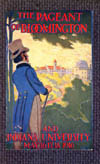 The Pageant of Bloomington and Indiana University was held May 16-18, 1916. William Chauncy Langdon wrote several of the pageants held that year, and they show a similar interest in using the phrase "Who's 'Yere" which sounded like "Hoosier" early in the Pioneer portions of the programs. Events depicted in the pageant included:
The Pageant of Bloomington and Indiana University was held May 16-18, 1916. William Chauncy Langdon wrote several of the pageants held that year, and they show a similar interest in using the phrase "Who's 'Yere" which sounded like "Hoosier" early in the Pioneer portions of the programs. Events depicted in the pageant included:
- The settling of Bloomington, 1818
- The founding of Indiana Seminary, 1820
- Installation of Andrew Wylie as University President, 1829
- Hoosier Opposition to Slavery, 1850
- The Start of the Civil War, 1861
Cass County

The Cass County Centennial Pageant was held June 2, 1916 in Logansport. The planning committee in Cass County wanted to especially highlight civic pride and optimism in the future in their pageant. The following events were depicted in the pageant, which was preceded by an interpretive dance of the seasons representing Indiana before the arrival of humans:
- Native American Village Life
- Fur Traders
- LaSalle
- Capture of Vincennes
- Removal of the Pottawatomies
- The Civil War
- The March of the States
Connersville / Fayette County
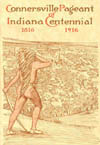
The Connersville Pageant was held July 5, 1916. Local history was important in the pioneer portion of the program, starting with the capture of John Conner by the Indians, the escape of the Jonas Williams family and the murder of Ben Davis. Other events depicted in the pageant included the following:
- Arrival of Indian Traders
- Circuit Rider
- Masonic Lodge
- Indianapolis-Connersville Wedding
- Fiddler's Contest
- Singing School
- Apple Peelings & Husking Bees
- A Harrison-Tyler Parade
- The Civil War
Corydon

The Pageant of Corydon was held June 2 and 3, 1916. It was written by the author of the Bloomington Pageant, William Chauncy Langdon. To the planners of the Centennial, Corydon held a special place in early Hoosier history, and it was Langdon's intention, "to commemorate the time of the pre-eminence of the town, when it was for 12 years, from 1813 to 1825, first the Territorial and then the State Capitol of Indiana." The events depicted in the Pageant included:
- A Welcome to Old Corydon
- Completion of the Court House
- Corydon, the Capitol
- The Constitutional Convention
- The New Capitol
Decatur County
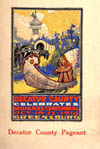
The Decatur County Centennial festival was held October 18-22, 1916 in Greensburg. The Decatur County pageant began with two interpretive dances representing Natural Resources and the Forest Primeval. Interpretive dances were a popular method of including eras for which there is no written record. In the Decatur County pageant one of the Natural Resources depicted was "Natural Gas," a figure with streamers who sprung out of the ground and recited a poem: "No dirt, no smoke/ Do I provoke,/ But joy invoke/ For the men of Indiana." The historical episodes of the pageant included the following:
- The origin of Indian tribes
- The white man's entrance
- Indian customs
- Pioneer Life
- Statehood
- A Decatur County Whig Rally in 1840
- Underground Railroad
- The Civil War
DuBois County
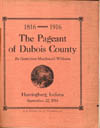
The DuBois County Centennial celebration was held September 22, 1916 in Huntingburg. The festivities began with a dance for the gifts of nature in which 350 people participated. The following episodes in history were included in the pageant:
- Granting the Vincennes tract of land to the French
- Raising the American flag on Vincennes soil
- The arrival of the McDonald family
- The Buffalo Trace Incident
- DuBois receives patent for land
- Last journey of Captain DuBois
- Events in the early history of DuBois County
Earlham College Pageant
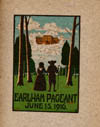
The Earlham College Pageant was held June 13, 1916 on the Earlham campus. The theme of the pageant was the settlement and activities of Quakers in the White River Valley and the founding of Earlham College. The following episodes were included in their presentation:
- A Hymn to Freedom
- Following the North Star
- The Quaker contribution to the Civil War
- The Founding of Earlham
- Centennial Observances
Fort Wayne
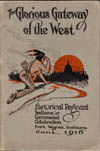
The Fort Wayne pageant was held in June 1916. Like the Corydon and Bloomington pageants, local milestones were the focus of the festivities. The following events were depicted in the pageant:
- French trappers trading with the Indians
- Fort Miami at the end of the French-Indian War
- The Eve of the Battle of Fallen Timbers
- The dedication of Fort Wayne and renaming of Fort Miami
- War of 1812
- Arrival of William Henry Harrison
- Decommission of the Fort
- Canal Building
- The Civil War
Franklin County
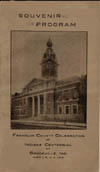
The Franklin County Pageant was held from June 1-4, 1916 in Brookfield. An unusual feature of this program was that it featured an Honor Roll of distinguished men born in Franklin County, along with sketches of historic places, and an exhibit of historic relics. The pageant that accompanied the festivities was set in 11 different scenes, including the following:
- A Native-American Scene
- Arrival of Whites
- Signing a treaty and smoking the peace pipe
- Pioneer life
- Husking Bee
- Organization of Franklin County
- Admission of Indiana into the Union
- Land Office & filing land claims
- Opening the canal
- Brookville College life: departure of students to enlist in the Civil War
- The Railroad
- Progress since the Civil War
Goshen
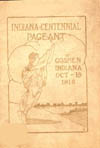
The Goshen Pageant was held on October 19, 1916. Unlike many pageants, the one in Goshen was largely allegorical, using symbolism of events and people to portray the history of Indiana. It started with a parade and an interpretive dance representing natural resources and beauty of Indiana before the arrival of people at the pageant grounds. The following events formed the body of the pageant:
- French traders and priests with the Native Americans
- Departure of the Native Americans
- Symbolic depiction of the States entering the Union, with Indiana last
- Circuit Rider
- Husking Bee
- Underground Railroad
- Civil War
- Grand Army of the Republic veterans
- Uncle Sam helping Indiana receive the people of Europe
Grant County
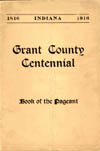
The Grant County Pageant was celebrated on October 2-7, 1916. The planners of the event intended that the program would provide an outline to make the Pageant easier to follow along from the stands. It also had advertisements, a feature that was unique among the collected programs at the Indiana State Library. The following events were depicted:
- The Organization of Grant County
- The Decree of the White Man to the Native American tribes
- The naming of Marion
- The Evolution of the United States Postal System
- The Abduction of Frances Slocum
- The Underground Railroad
- Battle of Mississinawa
- Lee's Surrender at the end of the Civil War
Henry County
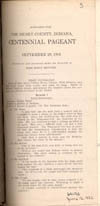 The Henry County Centennial pageant was presented on September 29, 1916. It had the following episodes:
The Henry County Centennial pageant was presented on September 29, 1916. It had the following episodes:
- Telling of legends by a Medicine Man
- Indiana becoming a state
- War with Mexico
- Customs of early days
- Progress in 1916
Irvington
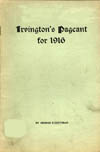 The Irvington Pageant was held July 4, 1916 in Ellenberger Park. According to the planners, it was more important for the large audience to have a visual experience of color, movement and grouping. The historical story was secondary to their concern of putting on a good show. It was also their intention "to make it a community affair and widely representative as a freewill offering in entertainment...It represents the hospitality of the town." The events depicted in the Irvington Pageant included the following:
The Irvington Pageant was held July 4, 1916 in Ellenberger Park. According to the planners, it was more important for the large audience to have a visual experience of color, movement and grouping. The historical story was secondary to their concern of putting on a good show. It was also their intention "to make it a community affair and widely representative as a freewill offering in entertainment...It represents the hospitality of the town." The events depicted in the Irvington Pageant included the following:
- The Admission of Indiana as a State
- The Purchase of land where Irvington stands from the Indians
- The coming of the Pioneer
- The Origin of Irvington
Johnson County
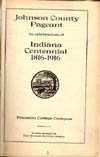
The Johnson County Centennial pageant was held on the Franklin College Campus. It was presented by the Woman's Civic League. In addition to the pageant, a historical sketch of the founding of Johnson County was presented. The Pageant included the following scenes:
- Trappers and Native American life
- Early Pioneers and home life
- The founding of Franklin College
- Society and Industry before the Civil War
- Politics and Patriotism/The Civil War
Miami County
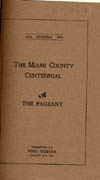
The Miami County Centennial pageant was held August 13-19, 1916 at Peru. The week of celebration started with a county-wide church service and the arrival of the Spirit of the Historic Past with a dedication of the Broadway Lighting System. Every other day that week had a theme: Frances Slocum Day, Township and Civic Day, Fraternal Day, and Industrial Day--each with their own parade. The pageant had several episodes, including the following:
- The Abduction of Frances Slocum
- Symbolic Dances
- Coming of the Indians
- Pioneers
- Destruction of Deaf Man's Village
- Treaty of 1826
- Pioneer Settlement
Michigan City
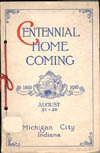
The Michigan City Centennial and Homecoming was held over five days, August 21-26, 1916. The planned festivities rivaled that of the Indiana State Fair that year. The days leading up to the parade and pageant were filled with activities like comedy and song acts, death-defying acts, baseball games, a Chautauqua, a fire drill, trapeze acts, Coast Guard drills, political speeches, and an appearance by the S.S. Theodore Roosevelt. On the day of the event, all of the stores and factories throughout the city were closed for a parade, daylight fireworks, and a pageant boasting the participation of 500 people. Local milestones were at the forefront of events depicted in the pageant and included the following:
- The First Visitors to the Dunes: Father Marquette & the Native Americans
- The Settling of the City in 1836
- The linking of Michigan City to the National Transportation Network
- The State Prison in the Dune City
- Spirit of Patriotism in 1861
- The Triumph of Beauty and Utility
Montgomery County
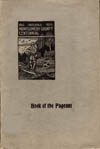
The Montgomery County Pageant was held June 9-14, 1916. Like many programs, this one did not intend to replicate the dialogue of the pageant, but to provide an easy to follow outline for the audience. Through the pageant, it was hoped that "to express our love and reverence for those pioneers...patriots...and literary geniuses," that had come before them. It was also desired that this pageant would bring to the community a sense of individuality and pride in the past and hope for the future. Starting with an interpretive dance representing the birth of the Indian race, the following events were included in the pageant:
- The Indian in the primeval forest
- Surveyors, settlers & speculators
- The naming of Crawfordsville
- The founding of Wabash College
- Caleb Mills
- The Civil War & Enlistment of the Wabash College Class of 1862
- Lew Wallace & Ben-Hur
- Maurice Thompson & "Alice of Old Vincennes"
New Albany
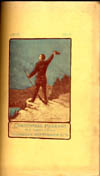
The New Albany pageant was held September 21, 1916 in Glenwood Park. It started off with several scenes depicting typical pioneer life in southern Indiana ending with the Governor's Ball in 1816. The second part was presented as a masque symbolizing the founding and growth of the state. It was staged in a park setting that had the effect of a natural amphitheater, which created the feel of an ancient forest, according to the pageant committee. In Episode One the following incidents were dramatized:
- The Indians and the coming of LaSalle
- George Rogers Clark at Corn Island
- Pioneers
- The Circuit Rider
The other portions of the masque consisted of the Spirit of the West meeting her daughter Indiana and the recognition of blessings like law, home, church, school, free womanhood, commerce, the arts, fame, and public health.
Owen County
The Owen County pageant was celebrated in Spencer on October 5 -6, 1916. The Chautauqua Grounds served as the place of the pageant and the following events were dramatized:
- The coming of the White Man
- The county seat in 1820
- Rally Round the Flag--the Civil War
- The meeting of past and present
Parke County
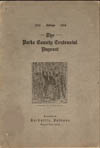
The Parke County Centennial was held August 12, 1916. Like many pageants, the planners hoped that this one would awaken the community to a feeling of pride and lead to a "more earnest citizenship in the future." It started with an interpretive dance depicting the Spirits of the Trees, Coal, Clay and Corn. The pageant included the following events:
- The Native Americans and the French
- Harrison's Army and the Departure of the Indians
- Election at Henry's Cabin
- Founding of Shiloh Church
- Naming of Rockville
- Departure of General Howard
- Barnabas Hobbs and the Underground Railroad
- The enlistment of the Rockville Union Guards
- A County Fair
Perry County
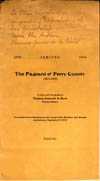
The Perry County Pageant was held September 7, 1916 in Cannelton. It consisted of ten episodes between 1804 and 1865. They included the following:
- Arrival of Pioneer Settlers
- Landing of the Lincoln Family at Troy
- Lafayette's steamboat wreck at Rock Island
- Founding of Leopold by Father Bessonies
- Laying the first stone of the Cannelton Cotton Mill
- Founding of Tell City by the Swiss Colonization Society
- Confederate Invasion of Perry County
Pike County

The Pike County Pageant was held August 3-4, 1916 on the Petersburg Fair Grounds. The program itself was prefaced by interpretive dances symbolizing nature and its blessings. The pageant was spread over two nights, the first covering history until the Battle of White Oak Springs; the second told about Indiana's accomplishments and history since becoming a state. The following episodes were included in the pageant:
- The Indians and French
- George Rogers Clark takes the fort at Vincennes from the British
- Tecumseh's Protest
- Battle of White Oak Springs
- Pioneer Life
- Underground Railroad
- Husking Bee
- The start of the Civil War and military drill
Posey County
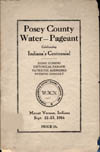
The Posey County pageant was held September 12-13, 1916. It included a parade, concert and military review prior to the pageant. As part of the Centennial festivities, a strong-box of Centennial valuables was deposited with the First National Bank, to be opened at the next Centennial in 2016. The pageant included some of the following events:
- Indians, fur traders, trappers, French Missionaries and the Pioneers
- The coming of Rappites
- The Owen community
- Establishing Mt. Vernon as the county seat
- The Hovey Campaign
- A Memorial to Civil War veterans
Saint Joseph County
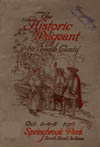
The Saint Joseph county pageant was held over three days, October 3-5, 1916. It was staged with three goals in mind: To know "more of the dreams, struggles, hardships and rewards of those sturdy pioneers;" To "enjoy with a fuller knowledge the improved conditions they left us;" and that "the community may be welded together in a common interest." It was staged with the cooperation of the University of Notre Dame and consisted of nearly twenty-five episodes, including the following:
- War between the Iroquois and Miami Indians
- Establishment of a Miami Village & Treaty
- Navarre enters, trades and marries the Chief's daughter
- Establishing a trading post
- South Bend is laid out, Michigan Road goes through
- Arrival of Father Badin, warning of the Black Hawk raid, leaving with the Pottawatomies
- Establishing a University at the Mission of Notre Dame
- Building Mishawaka
- Mishawaka Burns in 1872
- The Standpipe-Holly controversy between Pine and Studebaker
Shelby County
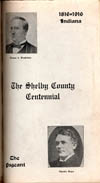
The Shelby County Centennial was held September 29, 1916 in Shelbyville. The pageant planners made an effort not to use events or characters which did not embody the development of Shelby County. It was primarily concerned with local events and history. Each of the episodes included in the pageant were chosen because of their importance to the development of the county. The five episodes consisted of the following:
- The Indian in the primeval forest & later peaceful removal
- The pioneers who cleared the forest and organized the county
- Home life following settlement
- The Great Civil War
- Areas of county development
Spencer County
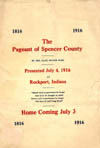
The Spencer County pageant was held on July 4, 1916 in Rockport. Like many pageants, the planners of Spencer County's made sure that some local events were included in the festivities. The festivities included the following:
- Treaty of Fort Wayne
- The Meeks Tragedy
- Locating the County Seat
- The Lincolns: Home-Coming, the mill, the departure
- Cornerstone laying of Rockport Academy
- St. Meinrad's Academy
- The Civil War
- The March of Commerce and Industry
The Pageant of Troy
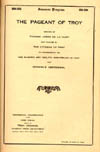
The Pageant of Troy was presented August 10-12, 1916. The festivities were held around speakers, political rallies, music, and a Chautauqua program. The pageant itself featured the following episodes:
- An Indian hunting party
- Arrival of Settlers
- Locating the County Seat
- Pioneer School
- Lincoln and his parents
- Volunteers enlisting for the Civil War in 1861
Vincennes
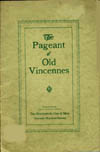
The Pageant of Old Vincennes was held May 19, 1916. This pageant was written by George S. Cottman who wrote The Centennial History of Indiana. It was entirely concerned with local history and occurred in five episodes, starting with a symbolic introductory dance. The others included:
- Founding of Vincennes
- Winning Vincennes
- Vincennes the capitol
- Finale: Indiana Exalted
Warrick County
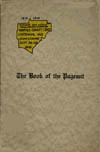
The Warrick County pageant was held September 28-19, 1916. In this pageant, many of the historic people were depicted by their lineal descendants. The events portrayed in the pageant included the following:
- Indian settlement and occupation of Warrick County
- Early Occupations and Amusements
- The Meeks Tragedy
- The First division of Warrick County and the relocation of the county seat
- Admission of Indiana to the Union
- A street scene in Boonville, 1861, when the call to arms goes up
White County
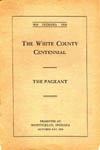
The White County Centennial festivities were held October 5-7, 1916. It had three main episodes describing Indiana, Pioneer and State periods of history. Episodes that were depicted included the following:
- The Wilderness
- Battle of Tippecanoe
- Pottawattomie Treaty of October 2, 1818
- Migration of Pottawattomies of White County
- Frances Slocum
- Trading Post at Wea
- Pioneer Church, Bees, School
- First County Board Meeting
- Admission into Union
- Underground Railroad
- Spirit of peace overcoming spirit of war
- White County prevails against the World in Spirit of Patriotism
RBM BF 10-6-2017

